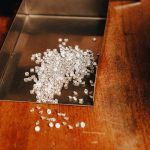Just like love, the diamond industry has giddy highs and despondent lows. After an initial pandemic-related decline in 2020, the overall business is seeing “a spectacular rebound,” according to Bain & Company’s Global Diamond Report, which came out in February. Throughout 2021, the study notes, revenue increased 62% in the mining segment, 55% in cutting and polishing, and 29% in diamond-jewelry retail. By the end of last year, prices for both rough and polished were almost back to pre-pandemic levels and historic averages, though analysts noted that the numbers were “still below their historic maximums,” says the report. Meanwhile, the personal-luxury market rose 35%.
Bain credits several factors with what it calls “decade-high growth” in the personal-luxury and diamond-jewelry categories. For one thing, “diamond-jewelry sales rebounded as Covid-19 restrictions relaxed, and experience-spending opportunities remained low,” the report says. “Marketing and a resurgence of wedding demand also lifted sales.”
This is good news for stores specializing in diamond wedding jewelry, of course, especially since prices are currently healthy in that category. The average cost of an engagement ring in the US is $6,000, according to The Knot 2021 Jewelry and Engagement Study, which the titular wedding website released at the end of last year. However, that number fluctuates by region, it found: the mid-Atlantic has the highest average outlay at $7,900, while the midwest has the lowest at $5,200. New England, the southwest, and the southeast average $7,400, $5,500 and $5,300, respectively.
As for size, the study puts the average diamond ring at 1.50 carats. While about half of all engagement rings fall between 1 and 2 carats, 25% are above 2 carats. Some couples opt for diamond alternatives to help lower costs, the report says; roughly one-third of all respondents spent between $1,000 and $4,000 on a ring, while 8% paid less than $1,000.
In contrast, fellow matrimonial website The Wedding Report pegged the average outlay for an engagement ring in 2021 at $3,603. Total sales amounted to $5.86 billion for an estimated 1.6 million rings, it found, and the median value was $2,111.
Natural attraction
Diamond industry analyst Paul Zimnisky confirms the figures from The Knot study. His own research has yielded a current average price of $4,000 to $8,000 for an engagement ring.
“Natural diamonds, specifically, are probably toward the higher end of that range,” says Zimnisky, adding that mined-diamond customers generally want rings over 1 carat, and older buyers spend more than younger ones. He expects prices in the category to remain stable, at least temporarily.
“Natural-diamond prices have been relatively firm in recent months. If the holiday season is good, we could certainly see higher prices in the first quarter of 2023,” he forecasts.
“This year, customers are still using money saved during the pandemic to spend on diamonds, maybe more than they would have otherwise,” he continues. “However, as the year progresses, it seems as if customers are drawing out the buying process over a longer period of time — so perhaps spending the same, but purchasing less impulsively.”
Developments big and small
During the pandemic, prices went up for larger diamond rings at New York-based jeweler The Clear Cut, which deals exclusively in mined stones.
“Since 2020, our average order value of engagement rings has risen 27%,” says cofounder and CEO Olivia Landau. “We’ve seen the largest increase in prices for mid-quality round brilliant diamonds. For example, a 2-carat, J, SI [stone] that in 2020 would have [cost] about $14,000 would now [cost] about $20,000, [which represents] a 42% increase.”
Meanwhile, nearly three years since the pandemic began, the market for smaller diamonds has softened, according to Sandy Ip, founder and designer at Hong Kong-headquartered jewelry brand Sevun. High prices are a factor, but these are stabilizing, she believes.
“Diamond prices went up in 2020 and 2021, but the rise of prices has stopped in recent months,” she says, adding that US demand remains constant.
Globally, “due to inflation and a possible economic slowdown, we see slower demand in diamonds below 2 carats. Demand for 3 carats and above seems steady,” she adds, noting that most of her clients won’t go below 1 carat.
What do you fancy?
But size isn’t the most important factor in engagement rings, according to The Knot; most couples are more interested in the cut and shape. In fact, the group says 41% of all engagement rings that sold in 2021 were round-cut diamonds, and white gold continues to be the most popular metal setting at 45%. Yellow gold comes in second at 20%.
Ip has found that “fancy-cut diamond engagement rings between 2 and 3 carats continue to be popular. Oval is the most popular, followed by radiant, emerald, pear and cushion cuts.”
Zimnisky has noticed pear and emerald cuts drawing attention. In addition, he observes, custom is still king — a trend that “is likely to continue, as customers want something different.”
Forward thinking
Having predicted a continuing rise in demand for diamond jewelry — as well as polished and rough loose diamonds — during the first half of 2022, the Bain report expresses optimism about the upcoming quarter. The market “anticipates a strong holiday season” and limited rough supply, and will likely “return to historic growth pace by 2023-24,” Bain says.
To capture consumer dollars, then, retailers will need to meet demand and market competitively. Commodification is no longer the best way to sell a diamond, says David Kellie, CEO of the Natural Diamond Council (NDC). He encourages retailers to think in terms of “elevating the dream, investing in marketing and communication, investing in store refurbishments, investing in staff development, and connecting with modern culture, [rather than] commoditizing the diamond purchase and behaving more in a transactional manner.”
Still, retailers such as The Clear Cut’s Landau understand that customers see an engagement ring in terms of monetary worth alongside its emotional value. Mined diamonds, she forecasts, will be viewed as an investment. “I’m assuming prices will decrease a bit, especially if there’s less demand in the 1-carat or 2-carat range and below. But I think it will continue to be an investment piece.”
BRON: Rapaport 6-9-2022




